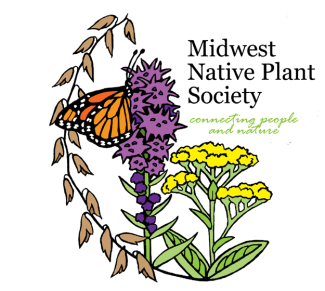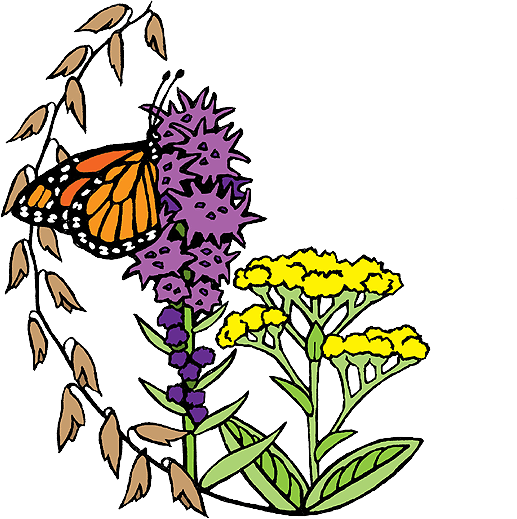Help to Grow Native
Get inspired and empowered to cultivate a thriving, native plant landscape with our Help You Grow hub!
Here, you'll find practical tips, regional plant recommendations, downloadable resources (like our Native Plant Pledge and yard sign guide), and links to trusted partners like Wild Ones and Grow Native!. Whether you're a beginner or seasoned gardener, this page offers the knowledge you need to create beautiful, biodiversity‑supporting gardens that nourish wildlife at every level.
Getting Started
When we plant native plants that are adapted to our area, we are going a long way to restore biodiversity and support the wildlife that has co-evolved with them. If we want to support our local butterflies and moths, we need to plant their native host plant to feed them when they are in the caterpillar stage and nectar plants for the adult stage. Many butterflies and moths require very specific plants to develop into the beautiful creatures that live among us. Think of the Monarch and its dependency on Milkweed leaves as a caterpillar and the Zebra Swallowtail that requires leaves from the PawPaw tree. An excellent resource can be found on the Indiana Native Plant Society website, “The Science Explained”.
Recent research by the entomologist Doug Tallamy, and the website Homegrown National Park, has shown that native oak trees support over 500 species of caterpillars. In contrast, ginkgos, a commonly planted landscape tree from Asia, host only 5 species of caterpillars. When it takes over 6,000 caterpillars to raise one brood of chickadees, that is a significant difference. Native shrub and tree branching is suitable and preferable for our native nesting birds over exotic plant species, which often contributes to nest failure.
Finding and Purchasing the Right Plants
Finding native plants that will thrive in your area can be challenging, especially straight native species, not cultivated species. Check out our Conference Page for a listing of quality native plant vendors/sellers that have recently participated in our conferences and other events. Reach out to them for more information and some great native plants and landscaping ideas. Many vendors in Ohio will ship to other areas. To find plants recommended for your particular region, the National Wildlife Federation offers a listing by zip code. To find the best native plants for birds/wildlife, another search by zip code can be found on the Audubon Society Native Plants database.
There are many options and beautiful plants to add to our landscape. Some people ask if adding native plants will look weedy in a landscape. There are so many varieties, shapes, and sizes to choose from! Remember that native plants include trees, shrubs, and vines that offer many design options. When using native plants in a garden design, there should be
no noticeable difference between a landscape planted with beautiful native trees, shrubs, vines, and wildflowers and a landscape planted with exotics from other countries.
Unfortunately, many plants for sale in local and mail-order nurseries are alien species from other countries. These exotic plants do not serve our native wildlife or food web, and many of these plants have become invasive, outcompeting native species and degrading habitats in remaining natural areas. Checking for the scientific name of the plant will aid you in making informed decisions.
Other Resources
- Birds & Biodiversity, Jim McCormac
- Ecological Horticulture, Rebecca McMakin
- Home Grown National Park, Doug Tallamy
- Edible Native Plants, PDF list compiled by conference speaker Debra Knapke, 2024.
- Planting Native in a World of HOA's and Weed Ordinances, Sam Settlemyre, Civic Garden Center, June, 2025
Wild Ones: Native Plants, Natural Landscapes
Is a national organization that promotes native landscapes through education, advocacy, and collaborative action. They promote environmentally sound landscaping practices to preserve biodiversity through the preservation, restoration, and establishment of native plant communities. There are many active chapters to help you on your journey. To find a local chapter near you, visit, https://wildones.org/chapters/.
In 2022, OSU Student and White Oak Scholarship Intern Brooke Decubellis attended the Midwest Native Plant Conference and interviewed, filmed, and photographed various attendees, speakers, trip leaders, and vendors. Many of her photos are used on this website and other materials.
Brooke created a series of videos for us to share to help you learn more about native plants. We appreciate Brooke’s work and are happy to share it with all of you.
"To Bring Back the Pollinators, I Pledge to: 1. Grow a variety of bee-friendly flowers that bloom from spring through fall, 2. Protect and provide bee nests and caterpillar host plants, 3. Avoid using pesticides, especially insecticides, 4. Talk to my neighbors about the importance of pollinators and their habitat.”
~ Xerces Society





